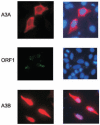APOBEC3 proteins inhibit LINE-1 retrotransposition in the absence of ORF1p binding
- PMID: 19845642
- PMCID: PMC4475406
- DOI: 10.1111/j.1749-6632.2009.05006.x
APOBEC3 proteins inhibit LINE-1 retrotransposition in the absence of ORF1p binding
Abstract
Members of the apolipoprotein B mRNA editing complex polypeptide 1-like (APOBEC) family of enzymes exhibit inhibitory activity against a variety of exogenous and endogenous retroviruses including retrotransposons, such as long interspersed element 1 (LINE-1). Indeed, human APOBEC3A, APOBEC3B, and APOBEC3F inhibit retrotransposition of human LINE-1, mouse IAP and MusD retrotransposons. In our study, we examined whether the inhibitory effect of APOBEC3 proteins correlates with APOBEC3 ability to bind the LINE-1 ORF1 protein. We examined the interactions between the LINE-1 ORF1 protein and the most potent LINE-1 retrotransposon inhibitors, human APOBEC3A and APOBEC3B, by immunofluorescence and immunoprecipitation. Although human APOBEC3A shows the highest inhibitory potency against LINE-1 retrotransposon, no direct interactions were identified either by immunofluorescence or by co-immunoprecipitation. APOBEC3B binds to LINE-1 ORF1 protein, yet no co-localization was detected. We concluded that APOBEC3 proteins interfere indirectly with the LINE-1 retrotransposition pathway, probably through interference with RNA targeting.
Figures




Similar articles
-
APOBEC3A and APOBEC3B are potent inhibitors of LTR-retrotransposon function in human cells.Nucleic Acids Res. 2006 Jan 10;34(1):89-95. doi: 10.1093/nar/gkj416. Print 2006. Nucleic Acids Res. 2006. PMID: 16407327 Free PMC article.
-
Intrinsic restriction activity by apolipoprotein B mRNA editing enzyme APOBEC1 against the mobility of autonomous retrotransposons.Nucleic Acids Res. 2011 Jul;39(13):5538-54. doi: 10.1093/nar/gkr124. Epub 2011 Mar 12. Nucleic Acids Res. 2011. PMID: 21398638 Free PMC article.
-
APOBEC3 proteins inhibit human LINE-1 retrotransposition.J Biol Chem. 2006 Aug 4;281(31):22161-22172. doi: 10.1074/jbc.M601716200. Epub 2006 May 30. J Biol Chem. 2006. PMID: 16735504
-
Post-transcriptional regulation of LINE-1 retrotransposition by AID/APOBEC and ADAR deaminases.Chromosome Res. 2018 Mar;26(1-2):45-59. doi: 10.1007/s10577-018-9572-5. Epub 2018 Feb 2. Chromosome Res. 2018. PMID: 29396793 Review.
-
Roles of APOBEC3A and APOBEC3B in Human Papillomavirus Infection and Disease Progression.Viruses. 2017 Aug 21;9(8):233. doi: 10.3390/v9080233. Viruses. 2017. PMID: 28825669 Free PMC article. Review.
Cited by
-
Endogenous APOBEC3A DNA cytosine deaminase is cytoplasmic and nongenotoxic.J Biol Chem. 2013 Jun 14;288(24):17253-60. doi: 10.1074/jbc.M113.458661. Epub 2013 May 2. J Biol Chem. 2013. PMID: 23640892 Free PMC article.
-
DNA transposon Hermes inserts into DNA in nucleosome-free regions in vivo.Proc Natl Acad Sci U S A. 2010 Dec 21;107(51):21966-72. doi: 10.1073/pnas.1016382107. Epub 2010 Dec 3. Proc Natl Acad Sci U S A. 2010. PMID: 21131571 Free PMC article.
-
LINE-1 retrotransposable element DNA accumulates in HIV-1-infected cells.J Virol. 2013 Dec;87(24):13307-20. doi: 10.1128/JVI.02257-13. Epub 2013 Oct 2. J Virol. 2013. PMID: 24089548 Free PMC article.
-
A computational analysis of the structural determinants of APOBEC3's catalytic activity and vulnerability to HIV-1 Vif.Virology. 2014 Dec;471-473:105-16. doi: 10.1016/j.virol.2014.09.023. Epub 2014 Oct 29. Virology. 2014. PMID: 25461536 Free PMC article.
-
Shape-based alignment of genomic landscapes in multi-scale resolution.Nucleic Acids Res. 2012 Aug;40(14):6435-48. doi: 10.1093/nar/gks354. Epub 2012 May 4. Nucleic Acids Res. 2012. PMID: 22561376 Free PMC article.
References
-
- Lander ES, et al. Initial sequencing and analysis of the human genome. Nature. 2001;409:860–921. - PubMed
-
- Brosius J. The contribution of RNAs and retroposition to evolutionary novelties. Genetica. 2003;118:99–116. - PubMed
-
- Belancio VP, Hedges DJ, Deininger P. Mammalian non-LTR retrotransposons: For better or worse, in sickness and in health. Genome Res. 2008;18:343–358. - PubMed
-
- Sassaman DM, et al. Many human L1 elements are capable of retrotransposition. Nat. Genet. 1997;16:37–43. - PubMed
Publication types
MeSH terms
Substances
Grants and funding
LinkOut - more resources
Full Text Sources
Research Materials

